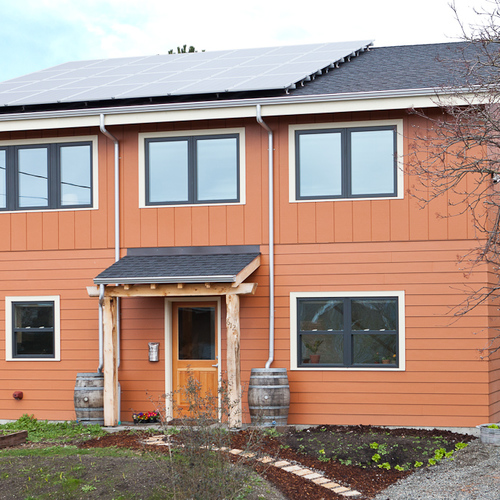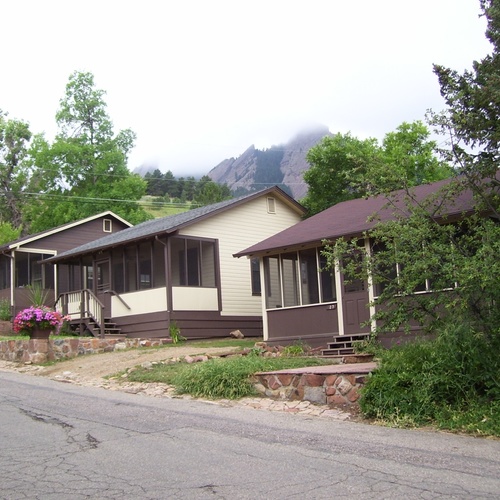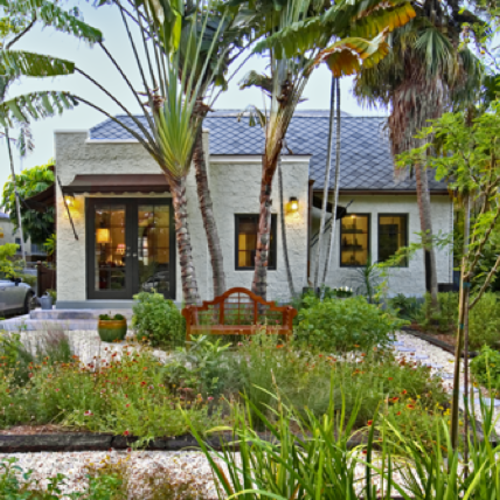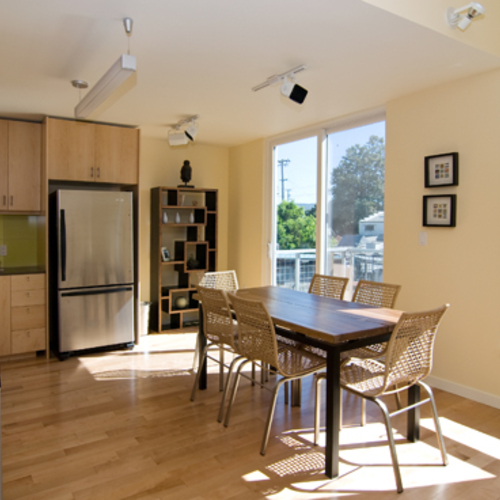
Image Credit: Matt Grocoff
Image Credit: Matt Grocoff The Grocoff home (complete with asbestos siding) before the start of the net-zero rehab project.
Image Credit: Matt Grocoff Before the Grocoffs' restoration, the attic had insufficient ventilation and the attic and walls had no insulation.
Image Credit: Matt Grocoff Because the old attic was poorly ventilated, the Grocoffs converted the space into an unvented conditioned attic by installing open-cell spray foam on the underside of the roof sheathing.
Image Credit: Ryan Stanton A large bedroom was split to create a smaller bedroom and an upstairs bathroom.
Image Credit: Matt Grocoff The upstairs bathroom was created with mostly reclaimed materials or materials with a high recycled content.
Image Credit: Matt Grocoff The original heart pine floors were restored without using any new materials.
Image Credit: Matt Grocoff Kelly Grocoff finishing floors with Bioshield Hard Oil #9
Image Credit: Matt Grocoff The parlor had an acoustic tile ceiling. Kelly Grocoff renovated the ceiling after removing the tiles.
Image Credit: Matt Grocoff The salvaged doors for the new upstairs bathroom came from Habitat for Humanity Restore. To make smart use of the space, the doors were installed on barn door sliding hardware.
Image Credit: Matt Grocoff Kelly Grocoff restored the original 110-year-old double-hung windows.
Image Credit: Matt Grocoff Using reclaimed materials, an old playhouse was converted to a chicken coop.
Image Credit: Matt Grocoff Matt Grocoff's choice of Sunpower Signature black PV modules helped him get unanimous approval for the rooftop system from the Ann Arbor Historic District Commission.
Image Credit: Bill Stevenson
A rehab project in Ann Arbor turns a house in a historic district into America’s oldest net-zero residence
There really is nothing more challenging that I can think of than taking a home in a historic district and taking it to net zero energy. But it sure helps to start with the right home.
Good bones
When I asked Matt Grocoff, “Why this house?,” the first words out of his mouth were, “Good bones!” Despite the home’s age, the foundation and structure were sound.
“But the beauty of this home goes well beyond the structure,” Matt is quick to add. “The interior finishes were original and appealing, the overall layout was classic and functional, and it’s in an ideal, walkable, neighborhood. And with the street running due north-south (as well as the eaves) and a near 45° roof pitch at 43° latitude, the home is a near perfect fit for a pretty large PV array.”
Honoring the history
While Matt and Kelly were determined to get to net zero on their home, it was definitely going to be by working with the home and its history, not against it.
“Creating energy is not the reason we live. It’s simply something that helps enable us to enjoy the things we live for: beauty, stories, joy, knowing your neighbors, honoring our interconnectedness and the past,” says Matt. “We feel connected to the families that lived here before us. Gertrude Gauss’ name [the original owner] is written in chalk on our basement ceiling. While we are here to stay, so are the Gausses as part of the stories of this home.”
Matt feels that this quote from Wendell Berry sums up their historic net zero energy home: “When looking back makes sense, we are going ahead.”
Getting to zero
Matt explains that there were two key elements of getting their home to net zero energy: vision and leverage. “We worked closely with our energy performance company, Meadowlark Energy and the non-profit Clean Energy Coalition, to analyze all the loads and map out a course. We knew our goal was to consume no more energy than we were capable of producing. Every decision we made was guided by this vision. After a few years of consumption data, we knew we were ready for solar.”
Matt describes the other key part of getting to zero as leverage. “When an opportunity arose that was part of the plan, we went after it immediately,” Matt relates. “When we began restoration, there was no tax credit for ground source heat pumps. But since rolling the cost into our mortgage gave us an immediate positive cash flow even before we had our insulation done, we took the opportunity while we could. As soon as our utility offered up their PV incentive (a $19 K upfront renewable energy credit and another $20 K over 20 years), we had The Solar Specialists calculate how many panels we could get on the roof. We could only leverage those opportunities this way because we knew ahead of time exactly where we were going and how.”
But Matt has a very strong addendum to add to the way he and Kelly approached getting to net zero. “While Kelly and I are completely committed to energy efficiency, we are not sacrificing comfort or convenience.”
For example, Matt switched out every single light bulb in his home from incandescent to CFL (and is now converting to LED), but he had his electrician Dan Delzoppo wire every light switch with LeGrand Wattstopper occupancy sensors. Matt and Kelly were all for low-flow showerheads and faucets that significantly reduce hot water demand (by over 11,000 gallons per year), but they had to be WaterSense models that did not compromise on performance.
“Another key element of this approach was to choose a home that was well-proportioned for our needs and made smart use of space. A large part of our load management is wrapped up in just 1,300 square feet of living space (2,500 square feet of conditioned space),” says Matt. “It’s no accident that the 8.1 kW of PV taking up our whole south-facing roof is just what we needed.”
Dealing with his state and local historic commissions
“Since we were not doing a gut rehab or an addition, we really started off on the right foot with our historic commissions,” says Matt. “We removed the asbestos shingles and restored the original clapboard siding. The biggest issues boiled down to our windows and the PV on the roof. We restored the original windows [see below] and used the SunPower Signature Black solar panels as the least obtrusive and best match to our asphalt shingle roof. It also helped that a gable faces the street and the PV-laden eave is perpendicular to the street view. Ultimately, the Ann Arbor Historic District Commission voted unanimously to approve the system.”
But believe it or not, Matt needed to add their conditioned attic to the list of historic preservation issues. Kelly and Matt applied to the Michigan State Historic Preservation Office (SHPO) to receive a $20,000 historic preservation tax credit, so the restoration needed to meet strict U.S. Secretary of the Interior preservation standards. The SHPO denied the application because of the Grocoff’s decision to use open-cell spray foam on the attic ceiling to create an unvented attic.
Matt says they are appealing the decision because “bringing the attic into the thermal envelope of the house eliminated the potential harm to the structure from the poorly vented attic (temperatures were measured at 125°F in April) as well as the danger of wind-driven rain through the gable windows.” The SHPO believed the spray foam would be detrimental to the roof structure, was irreversible and impairs the “essential form and integrity of the historic property.”
Matt says that while he does not believe spray foam is appropriate in all projects, he believes he has compelling data to support his decision that this was the best choice for his restoration.
Tracking net zero
Matt and Kelly are just about as transparent as you can get about just how their Mission Zero House performs — you can track their total and real-time electrical production from their website: Matt and Kelly’s Live Energy Production.
You can view annual and daily PV production and, with the micro-inverters you can see the performance of each individual panel. And Matt regularly posts updates on their total annual consumption: “While we are running a bit off of our projections for energy production, we are also running a bit lower on our total electric consumption. And removal of an obstructing (and invasive) Norway maple will boost our production.”
Matt is quick to add that that one maple is more than offset by the unburned coal and the seven fruit trees he and Kelly have planted. In 2012, using an eMonitor, Matt will begin posting his consumption down to each appliance.
Not really leaving the windows alone…
The trick with historic double-hung windows is to make it look as though you have left them alone when in fact you have improved their energy performance.
“I was really lucky to meet Lorri Sipes of Wood Window Repair Company,” says Matt. “Lorri set up a clinic at our home to help train others in this lost craft. Our work brought the original sashes up to fully functional, airtight performance with a 70% total whole-house air leakage reduction. After the 7 steps in Lorri’s workshop, we added to the window performance with Trapp air-tight, low-e storms. These high-performance storms have a baked-enamel color finish that blends in with the original sash.”
NOTE: I asked Sipes about how her business addresses lead safety, since I did not see anything on her company’s website on this subject. Sipes has been trained in EPA’s Lead Safe Workplace and follows all requirements to protect her clients from lead dust. She also uses EPA’s Renovate Right when working with do-it-yourselfers.
Matt and Kelly also like the way that their new EcoSmart insulated cellular shades are a perfect addition to the appearance and the performance of their windows. “Again, we really like products and systems that honor the character of our home, boost its performance, and do so with steady or even greater convenience.”
What’s next for Thrive
Matt is definitely a “practice what you preach” kind of guy; Thrive is his net zero consulting collaborative. “There has been a lot of interest in achieving net zero in existing homes. One project we are excited about is the historic Felt Mansion in western Michigan in the Saugatuck Dunes. When built in the mid-1920s, the property was powered by 16 wind turbines and even had a wave undulation machine that pumped water from Lake Michigan up to the house — in this case, we will be taking the project back to net zero!”
The Atlantic called the Grocoff’s home “sustainable perfection.” But Matt says “I won’t accept such praise until our home actually restores the environment rather than steals from it. I am also really excited by the fit between my net-zero work and the Living Building Challenge.” Kelly and I are working hard to move our Mission Zero home to zero water and waste, as well as energy — Amory Lovins says that ‘if it exists, it must be possible’. We’re proving what’s possible — so stay tuned!”
Weekly Newsletter
Get building science and energy efficiency advice, plus special offers, in your inbox.
Lessons Learned
“We have a ‘wish list’ for our Mission Zero home," says Matt, "but it turns out that just about every single wish item is related to meeting the Living Building Challenge”:
- Rain barrels to cistern: “Our rain barrels are really not anywhere close to the capacity we need to keep what we need on site. So we need to figure out a cistern system for our home and land.
- Induction cooktop: “We need to eliminate the gas combustion and double the efficiency of the stove from 45% to 90% to keep our electrical loads down.”
- Dual plumbing system and composting toilets: This will be a big part of controlling the size of our cistern; just need to find attractive, convenient composting toilets!”
- LED lighting in every fixture: “Phillips and The Home Depot have really helped out here; you can buy a full range of LED bulbs now with some under $20!”
- Green roof for front porch: “This will look great from the second floor, won’t be visible from the street and will keep the summer heat off the porch and front rooms.”
General Specs and Team
| Location: | Ann Arbor, MI |
|---|---|
| Bedrooms: | 3 |
| Bathrooms: | 2 |
| Living Space: | 1300 |
| Additional Notes: | 2,600 sq. ft. of conditioned space |
General Contractor: Matt Grocoff, Greenovation.tv Whole-House Performance Contractor: Meadowlark Energy
Construction
Attic: From uninsulated and vented to cathedralized and unvented
Above-Grade Walls: From uninsulated rough-cut 2x4s to dense-packed cellulose insulation (no vapor retarder)
Below-Grade Walls: From uninsulated to spray foam at the rim joist
Windows: From original single-pane windows to rebuilt/repaired original sashes plus low-e storms
Energy
Heating/cooling: 3-ton Water Furnace Envision
Window restoration: Wood Window Repair Company
Lighting Controls: Wattstopper motion sensor light switches
Power strips: Smart Strip power strips
Window treatments: EcoSmart Insulated cellular shades
Energy Specs
Attic insulation/air sealing: R-30 Demilec Sealection 500
Wall insulation: R-13 Farmers dense-packed cellulose insulation
Windows: Trapp low-e storms
Air tightness: 4.75 ach50
Water Efficiency
Toilets: Caroma Dual-Flush
Showerheads: Caroma 1.28 gpm (HET)
Faucets: Bricor aerators
Irrigation: Rain barrels (salvaged from St Jullian's Winery)
Indoor Air Quality
Whole-house ventilation: Ultimate Air ERV
Paints: Zero VOC - Benjamin Moore Aura, AFM Safecoat, Sherwin Williams Harmony
Floor finish: Bioshield Hard oil #9
Molding finish: Hock natural shellac
Bedding: NaturePedic mattress
Green Materials and Resource Efficiency
Salvaged doors: HFH ReStore
Picture frames: Urban Ashes
Salvaged wood stock: Urban Wood
Outbuilding: Chicken coop salvaged from neighbor's playhouse
Carpet: Wool stair runners from G & K Flooring
Alternate Energy Utilization
Alternative Energy: SunPower 8.1 kW photovoltaic system
Certification
- HERS 37
- USA Today's Best Green Homes of 2010











0 Comments
Log in or create an account to post a comment.
Sign up Log in